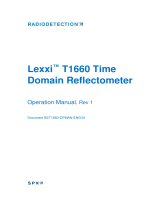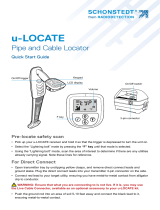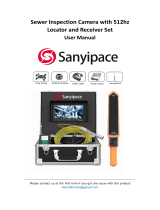Page is loading ...

RD5100
™
S
Multifunction precision
cable and pipe locator
User Guide
PART NO. 90/UG111INT/01

2
Preface
About this guide
CAUTION: This guide provides basic operating instructions for the RD5100S locator. It
also contains important safety information and guidelines and as such should be read in
its entirety before attempting to operate the RD5100S locator.
This guide is intended as a quick reference guide only. For detailed instructions, including
the use of accessories, please refer to the RD5100S locator operation manual, which is
available for download from: www.radiodetection.com
Certicates of conformity for the RD5100S locator can be found at:
www.radiodetection.com
WARNING: Direct connection to live conductors is POTENTIALLY LETHAL. Direct
connections to live conductors should be attempted by fully qualied personnel only
using the relevant products that allow connections to energized lines.
WARNING: The optional transmitter is capable of outputting potentially lethal
voltages. Take care when applying signals to any pipe or cable and be sure to notify
other technicians who may be working on the line.
WARNING: Risk of Hearing Loss. The locator emits noise levels which can
cause partial or total hearing loss. When using headphones these must have an
independent volume control. Set the volume level to its lowest value before donning
the headphones.
WARNING: This equipment is NOT approved for use in areas where hazardous
gases may be present.
WARNING: When using the optional transmitter, switch o the unit and disconnect
cables before removing the battery pack.
WARNING: Batteries can get hot after prolonged use at full output power. Take
care while replacing or handling batteries.

3
eCert
The RD5100S locator is safety equipment which should be regularly checked
to ensure its correct operation.
eCert
1
provides a thorough test of the RD5100S’s locating circuitry, and
supplies a Radiodetection Calibration Certicate when a positive test result is
obtained.
Refer to the RD5100 Manager
1
operation manual for further details. Additional
purchase may be required.
1 Contact Radiodetection for eCert and RD5100 Manager availability.
3 Year Extended Warranty
The RD5100S locator is covered by a 1 year warranty as standard. Customers
can extend their warranty period to a total of 3 years by registering their
products within 3 months of purchase.
Visit https://portal.radiodetection.com/ to create your company portal
account, and use the Product page to register your locator or transmitter.
Information on how to create a company account can be obtained from:
https://support.radiodetection.com
From time to time Radiodetection may release new software to improve the
performance or add new functionality to its products. By registering, users
will benet from email alerts advising about new software and special offers
related to its product range.
Users can opt-out at any time from receiving software and technical
notications, or just from receiving marketing material by contacting
Radiodetection.

4
RD5100S locator
1
2
3
4
5
7
6
8
10 12
11
9

5
Locator features
1. Keypad.
2. LCD with auto backlight.
3. Speaker.
4. Battery compartment.
(Optional Lithium-Ion battery pack).
5. Accessory connector (Not used).
6. Headphone connector.
7. Mini USB-B port
(inside battery compartment).
Locator keypad
8. Power key.
9. Up arrow key.
10. Down arrow key.
11. Backlight sensor.
12. Frequency key.
Locator screen icons
13. Signal strength bargraph with
peak marker.
14. Signal strength readout.
15. Proportional Guidance arrows.
16. Battery level.
17. Sensitivity readout.
18. Frequency readout.
19. Sonde icon: Indicates that a sonde
signal source is selected.
20. Compass: Shows the orientation
of the located sonde relative
to the locator.
21. Antenna mode icon:
Indicates antenna mode selection:
Guidance / Peak+.
22. Line icon: Indicates that a line signal
source is selected.
23. Depth readout, metric or imperial
(conguration dependent).
13
14 1515
16
17
2120 1918
22
23

6
Keypad actions and shortcuts
Switch the locator on by pressing the power key. Once powered up, the keys
function as follows:
Locator keys
KEY ● SHORT PRESS ●■■■● LONG PRESS
– Switch power off
Switch sonde frequency (options
include: 512Hz
(i)
/ 640Hz
(i)
, 8kHz and
33kHz)
Switch between Guidance and
Peak+ with guidance arrows
Set gain to mid position and
increases gain in 1dB increments
in Peak+ mode.
Rapidly increases gain in 1dB
increments in Peak+ mode.
Set gain to mid position and
decreases gain in 1dB increments
in Peak+ mode.
Rapidly decreases gain in 1dB
increments in Peak+ mode.
Note.
(i)
Conguration dependent.
Tip. Gain values set for each sonde frequency are stored internally and available when the unit
is powered on.

7
Before you begin
IMPORTANT
This guide is intended to be a quick reference guide. We recommend you read the full
operation manual before you attempt to operate the RD5100S locator.
First use
The RD5100S locator can be powered by D-cell alkaline batteries,
D-cell NiMH batteries, or by an accessory Lithium-Ion (Li-Ion) battery pack.
To t the D cell batteries in the locator, open the battery compartment and insert two
D-Cell Alkaline or NiMH batteries, taking care to align the positive (+) and negative (-)
terminals as indicated.
Rechargeable battery packs
Lithium-Ion battery packs are available for the locator, providing superior performance
over traditional alkaline batteries. To t these rechargeable packs, follow the
instructions provided with each pack.
Checking the system software version and last
calibration date
To check which version of software is running on your locator and the date of the last
calibration, press and hold the
key when switching the locator on. This information
may be asked for when contacting Radiodetection or your local representative for
technical support.
System setup
Regional and operational requirements are factory congured, no set-up is required.

8
Locating pipes with a sonde
For more detailed descriptions of using
the locator, and for detailed sonde
locate techniques, refer to the RD5100S
Operation Manual.
Make sure the sonde frequency matches
the selected locator sonde frequency.
Note: The 'blade' of the locator must
be in-line with the central axis of the
sonde.
A new battery or a freshly recharged battery should be used at the beginning of each
day and preferably at the start of a job. Check that the locator and sonde are working
correctly.
A quick test for both sonde and locator is to position the sonde at ground level at a
distance equal to its rated depth range from the locator. Point the locator at the sonde
with its blade in-line with the sonde, and check that the bar graph on the locator
displays more than 50% with the sensitivity of the locator set to maximum.
With the sonde in place at the survey
location, hold the locator vertically and
directly over the sonde's estimated
position. Make sure the blade is in-line
with the sonde. Adjust the sensitivity
(gain) of the locator to give a bar graph
display reading between 60% and 80%.
A sonde radiates a peak radio frequency
eld from the center of its axis with
weaker signal (ghost) lobes at each
side. Ghost lobe identication helps to
conrm the accuracy of the peak (center)
position. Move the locator a little way to
one side and then along the axis of the
sonde iteratively forwards and backwards
to detect the ghost lobes. Reduce the
sensitivity of the locator until the ghost lobes are no longer detected.
With the locator sensitivity set as desired, propel the sonde along three to four paces
and stop.

9
Place the locator over the estimated
position of the sonde:
1. Refer to Figure 1.
Move the locator backwards and
forwards with the blade in-line with the
sonde. Stop when the locator display
indicates a clear peak response.
2. Refer to Figure 2.
Rotate the locator as if the blade were a
pivot, stop when the display indicates a
clear peak response.
3. Refer to Figure 3.
Move the locator from side to side
until the display indicates a clear peak
response.
4. Repeat Steps 1 to 3 in smaller
increments with the locator blade
resting on or near the ground. The
locator should now be directly above
the sonde with the blade in line with the
sonde. Now mark the position.
5. Propel the sonde a further three to
four paces along the drain or duct
and pinpoint and mark. Repeat this
procedure along the route at similar
intervals. It should only be necessary
to change the locator sensitivity while
tracing the sonde if there is a change
in the depth of the drain or duct, or the
distance between locator and sonde.
Figure 2:
Figure 1:
Figure 3:

10
Locate Modes
The RD5100S locator oers a choice of two locate modes for each sonde frequency.
These are designed to maximise the eective use of sonde devices for pipe detection.
To switch between locate modes, press and hold the
key. Modes are described as
follows:
GUIDANCE: Proportional arrows and a ballistic ‘needle’ combine with audio
left/right indication for rapidly tracing the general path of a buried utility.
PEAK+: A peak bargraph provides a visual readout of the signal strength with
proportional Guidance arrows for rapid line tracing.
Depth and compass readout
WARNING: Never use the depth measurement readout as a guide for mechanical or
other digging activity. Always follow safe digging guidelines.
The RD5100S locator can measure and display sonde depth and the relative orientation
of a sonde to the locator. This helps you to make sure that you are following the right
pipe, especially when other utilities are present.
The RD5100S locator features TruDepth
™
, a feature that helps you to ensure the
accuracy of your locates. The depth is automatically removed from the display when
the locator is at an angle of more than 7.5° from the path of the pipe being located,
or when the locator determines that signal conditions are too poor for reliable
measurements.
Using accessories
The RD5100S is compatible with a range of sondes and exrods. For detailed information
on using these accessories please refer to the RD5100S locator operation manual.
Sondes and Flexrods
Sondes are battery powered transmitters that are useful for tracing non-metallic pipes.
They can be xed to Flexrods to allow them to be pushed through pipes or conduits,
and some are suitable for blowing through ductwork. The RD5100S can detect a range
of sonde frequencies, including those transmitted by exiprobe
™
pushrod systems and
exitrax
™
crawlers.

11
Optional transmitter
For information on using the RD5100S with an optional transmitter, please refer to a
Radiodetection precision locator operation manual that covers transmitters.
Training
Radiodetection provides training services for most Radiodetection products. Our
qualied instructors will train equipment operators or other personnel at your preferred
location or at Radiodetection headquarters. For more information go to:
www.radiodetection.com or contact your local Radiodetection representative.
Care and maintenance
The RD5100S locator and optional transmitter are robust, durable and weatherproof.
However you can extend your equipment’s life by following these care and maintenance
guidelines.
General
Store the equipment in a clean and dry environment.
Ensure all terminals and connection sockets are clean, free of debris and corrosion and
are undamaged.
Do not use this equipment when damaged or faulty.
Batteries and power supply
Only use the rechargeable battery packs, chargers and power supplies approved by
Radiodetection.
If not using rechargeable packs, use good quality Alkaline or NiMH batteries only.
Batteries should be disposed of in accordance with your company’s work practice, and/
or any relevant laws or guidelines in your country.
Cleaning
WARNING: Do not attempt to clean this equipment when it is powered or
connected to any power source, including batteries, adapters and live cables.
Ensure the equipment is clean and dry whenever possible.
Clean with a soft, moistened cloth. Do not use abrasive materials or chemicals as they
may damage the casing, including the reective labels. Do not use high pressure jets of
water to clean the equipment.
If using this equipment in foul water systems or other areas where biological hazards
may be present, use an appropriate disinfectant.

12
Software upgrades
From time to time, Radiodetection may release software upgrades to enhance features
and improve performance of the RD5100S locator or optional transmitter. Software
upgrades are free of charge and provided through a software manager Personal
Computer (PC) application.
E-mail alerts and notication of new software releases are sent to all registered users.
Disassembly
Do not attempt to disassemble this equipment under any circumstances. The locator
and optional transmitter contain no user serviceable parts.
Unauthorized disassembly will void the manufacturer’s warranty, and may damage the
equipment or reduce its performance.
Service and maintenance
Regulary check your equipment for correct operation by using eCert.
The locator and optional transmitter are designed so that they do not require regular
recalibration. However, as with all safety equipment, it is recommended that they are
serviced and calibrated at least once a year either at Radiodetection or an approved
repair center.
NOTE: Service by non-approved service centers may void the manufacturer’s
warranty.
Details of Radiodetection oces and distribution partners can be found at:
www.radiodetection.com
Radiodetection products, including this guide, are under continuous development and
are subject to change without notice. Go to www.radiodetection.com or contact your
local Radiodetection representative for the latest information regarding the RD5100S
locator or any Radiodetection product.


90/UG111INT/01
© 2018 Radiodetection Ltd. All rights reserved. Radiodetection is a subsidiary of SPX Corporation. Radiodetection eCert and RD5100S
are either trademarks of Radiodetection in the United States and/or other countries. Due to a policy of continued development,
we reserve the right to alter or amend any published specication without notice. This document may not be copied, reproduced,
transmitted, modied or used, in whole or in part, without the prior written consent of Radiodetection Ltd.
Visit www.radiodetection.com
Global locations
Radiodetection (USA)
28 Tower Road, Raymond, Maine 04071, USA
Tel: +1 (207) 655 8525 Toll Free: +1 (877) 247 3797 rd.sales.[email protected]
Pearpoint (USA)
39-740 Garand Lane, Unit B, Palm Desert, CA 92211, USA
Tel: +1 800 688 8094 Tel: +1 760 343 7350
Radiodetection (Canada)
344 Edgeley Boulevard, Unit 34, Concord, Ontario L4K 4B7, Canada
Tel: +1 (905) 660 9995 Toll Free: +1 (800) 665 7953 rd.sales.[email protected]
Radiodetection Ltd. (UK)
Western Drive, Bristol, BS14 0AF, UK
Tel: +44 (0) 117 976 7776 rd.sales.uk@spx.com
Radiodetection (France)
13 Grande Rue, 76220, Neuf Marché, France
Tel: +33 (0) 2 32 89 93 60 rd.sales.[email protected]
Radiodetection (Benelux)
Industriestraat 11, 7041 GD ’s-Heerenberg, Netherlands
Tel: +31 (0) 314 66 47 00 rd.sales.nl@spx.com
Radiodetection (Germany)
Groendahlscher Weg 118, 46446 Emmerich am Rhein, Germany
Tel: +49 (0) 28 51 92 37 20 rd.sales.[email protected]
Radiodetection (Asia-Pacic)
Room 708, CC Wu Building, 302-308 Hennessy Road, Wan Chai, Hong Kong SAR, China
Tel: +852 2110 8160 rd.sales.asiapaci[email protected]
Radiodetection (China)
13 Fuqianyi Street, Minghao Building D304, Tianzhu Town, Shunyi District,
Beijing 101312, China Tel: +86 (0) 10 8146 3372 rd.service.[email protected]
Radiodetection (Australia)
Unit H1, 101 Rookwood Road, Yagoona NSW 2199, Australia
Tel: +61 (0) 2 9707 3222 rd.sales.[email protected]
/




